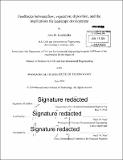Feedbacks between flow, vegetation, deposition, and the implications for landscape development
Author(s)
Kondziolka, John M. (John Michael)
DownloadFull printable version (15.64Mb)
Other Contributors
Massachusetts Institute of Technology. Department of Civil and Environmental Engineering.
Advisor
Heidi M. Nepf.
Terms of use
Metadata
Show full item recordAbstract
Flow and sedimentation around patches of vegetation are important to landscape evolution, and a better understanding of these processes would facilitate more effective river restoration and wetlands engineering. In wetlands and channels, patches of vegetation are rarely isolated and neighboring patches influence one another during their development. This patch-to-patch interaction, and its influence on landscape evolution, was examined through laboratory experiment and numerical modeling. In an experimental study, an adjacent pair of emergent vegetation patches were modeled by circular arrays of cylinders. The flow and deposition patterns behind the pair of patches were measured for two stem densities and for different patch separations (gap widths). For all gap widths (A), the velocity on the centerline between the patches (Uc) was elevated to a peak velocity Umax that persisted over a distance L. Although Umax was not a function of [delta], L decreased with decreasing [delta]. Beyond Lj, the patch wakes merged, and Uc decayed to a minimum at a distance Lm. The merging of wakes and associated velocity minimum produced a local maximum in deposition downstream from and on the centerline between the patches. If this secondary region of enhanced deposition promotes new vegetation growth, the increased drag on the centerline could slow velocity between the upstream patch pair, leading to conditions favorable to their merger. The patch-scale interactions documented in the lab were incorporated into a model of vegetation evolution. The initial flow field was solved using a porous media formulation for hydraulic resistance, and the velocity in wake regions was adjusted to match the wake structure measured in the laboratory study. Vegetation growth was added based on a probabilistic growth function linked to the velocity field. The simulations explored the influence of initial plant density (ID) and threshold velocity (TV, the velocity above which no plants can grow) on landscape evolution. Three types of stable landforms occurred: full vegetation coverage, channeled, and sparse. Full vegetation coverage was achieved for ID >/_ 5% when wakes were included, whereas simulations that excluded the influence of wakes rarely reached full coverage. The model highlights the role of flow diversion into bare regions (channels) in the promotion of growth within vegetated regions.
Description
Thesis: S.M., Massachusetts Institute of Technology, Department of Civil and Environmental Engineering, 2014. Cataloged from PDF version of thesis. Includes bibliographical references.
Date issued
2014Department
Massachusetts Institute of Technology. Department of Civil and Environmental EngineeringPublisher
Massachusetts Institute of Technology
Keywords
Civil and Environmental Engineering.